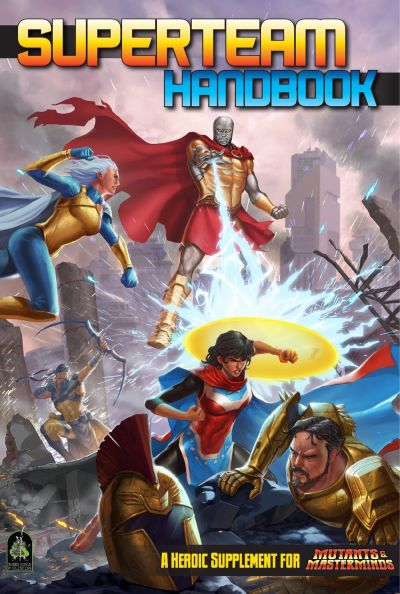Here They Come Just in Time
Superteam Handbook
By Jennifer DK, Crystal Frasier, Steve Kenson, Jack Norris, John Polojac, Lucien Soulban, Miranda Sparks, Fred Wan & Jordan Wyn

26 May, 2020
0 comments
Green Ronin’s 2019 Superteam Handbook is intended for use with their Mutants and Masterminds superhero roleplaying game. It’s a source book for game masters, with advice on how to run superhero teams in an SHRPG.
As is appropriate for a product of this nature, Superteam Handbook is a team effort:
- Writing & design: Jennifer DK, Crystal Frasier, Steve Kenson, Jack Norris, John Polojac, Lucien Soulban, Miranda Sparks, Fred Wan, and Jordan Wyn
- Development: Crystal Frasier Editing: Samantha Chapman
- Art direction: Hal Mangold Graphic Design: Crystal Frasier
- Cover art: Conceptopolis
- Interior art: Domenico Neziti, Alberto Foche, & Denis Medri
- Publisher: Chris Pramas
Although there are many sub-chapters, which I will not list individually — cue cheering from readers not keen on the fishbone approach — there are a mere three chapters in this nearly 170-page book.
Introduction
Five pages that provide an overview of the supplement. Although the meat of the advice is to be found later in the handbook, the introduction takes the time to underline some major points: learn some basic communications tools, learn something about your players before you start GMing. Things such as what kinds of situations — seeing children endangered in the game or a specific song or film — are off-putting or actively distressing. Different players will no doubt draw their lines in different places. The text encourages frank communication between participants before the game starts, to avoid unpleasant surprises during play.
Chapter 1: Knowing Your Team
Seventeen pages which expand on the points mentioned in the previous paragraph.
Starts with an overview of teams in superhero comics (Western and otherwise). The text then moves into Doylist and Watsonian (out-of-game and in-game) reasons for assembling teams. Players like to play with their friends, but that doesn’t mean that they should form teams based on friendship alone. There’s an overview of the pluses and minuses to teamwork and a list of the common personality types to be found among players.
For groups that need a kickstart, there is both a random team-theme generator and a team-name generator.
Chapter 2: Building Your Team
Twenty-five pages.
The handbook encourages group effort. Rather than having each player design their own character, in the hopes that individual decisions will add up to a strong team, it’s better for players and GM to coordinate at the start. They need to consider team roles — what function or functions does each character fill?
Factors to consider do not stop at individual character design. Also discussed are shared resources, from bases to vehicles, and effective combat choreography.
Chapter 3: Team Lineups
Remainder of the book
This section provides group and individual write-ups for eight different superteams. Teams range from powerful to ragtag, characters range from super-duper heroes to street-level types.
Index
THERE IS AN INDEX.
Indexes are a vital element of any RPG sourcebook.
~oOo~
I reviewed Strike Force before I reviewed this handbook because I wanted to do a compare and contrast. Now, because I have the handbook only in pdf, I cannot compare the two books as physical artefacts. I can say that the art in this book seems more ambitious than that in the Hero Games supplement. I regret to say that both books have typos, as is unfortunately typical for the RPG industry. Hire some proofreaders, folks!
Allston’s effort (Strike Force) has had what appears to be a clear influence on Superteam Handbook. The two books are even organized in similar fashion. But … what appears to be so may not be so. Strike Force is more than thirty years old right now, which is like, a hundred in game years. The designers could well be too young to have read Strike Force. Any similarities between the books could be attributed to parallel development, the sort of thing detailed in this essay by a four-time Hugo finalist.
I couldn’t stop wondering about this issue, so I cheated. I emailed Green Ronin and asked. The writers were indeed familiar with Allston’s effort.
But … while this handbook has been influenced by Allston’s Strike Force, the Green Ronin product is not at all a copy. There are issues covered here that few people considered back in 1988. The personality types and team roles featured in this work are not Allston’s. One very basic difference is the page count devoted to campaigning advice: Allston devoted about a dozen pages to the topic. The Green Ronin team provided more than three times the page count to campaign advice before diving into examples of functional teams. Strike Force may have been the foundation for Superteam Handbook, but Green Ronin has built an impressive edifice on top of it.
Green Ronin’s Superteam Handbook is intended for use with their Mutants and Masterminds superhero RPG. However, much of the advice given is applicable to most SHRPGs. The GMing advice could be usefully consulted for GMs running Champions, Icons, BASH or many other SHRPGs. Why, with a little work, some of it can be adapted to other genres. I would recommend it to anyone running ensemble roleplaying games.
Superteam Handbook is available here.
